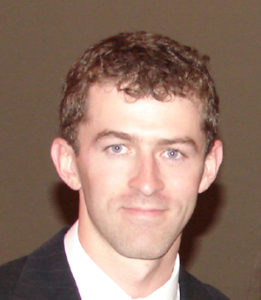MADISON, Wis. – In his Master’s of Engineering Engine Systems program, Aaron Foege was recruited by his peers to join groups creating engines for vast ocean liners, massive power plants and vintage aircraft.

But Foege wanted to create something different from his day-job, his team had an idea for their master’s project that would help the engineering engine systems industry.
Two years later, this idea was patented for Caterpillar Inc. On the patent, listed under “Inventors” are the names Aaron Foege, Derek Tanis and Joseph Roth.
“We had a problem that we had to solve, so we came up with a novel idea to fix that,” Foege said.
The engine the three students created was part of a project within the program. Students are to design an original engine system that they will use and study throughout their tenure in the program. This particular engine was built for economy cars.
“We chose to do a more boring design, from one perspective. Just an automotive engine that would go in an economy car,” Foege said. “Just your subcompact car that has a bigger market for a lot more of them but does not tolerate cost well.”
Foege and his team ran into a problem when trying to find the technology for a method they hoped to employ in their engine. They soon realized that no such technology existed.
The team needed to combine two parts of their engine; the camshaft and the crankshaft. The camshaft is a device that lifts engine valves open. The crankshaft spins around the connecting rods to make the pistons oscillate, and captures the energy from burning gases.
“We liked our idea to integrate them together, but we couldn’t use any of the methods that are out there to vary the cam timing and the valve timing,” Foege said.
According to Foege, an important part of how an engine works is how its valves open to let engine exhaust out and clean air in. For their compact car engine, his team needed to find a way to manually control this process.
“If I can change when those valves are opening while the engine is running, that gives me a great deal of power to really tune the engine,” Foege said.
According to Foege, the team was able to solve the problem because the program requires students to lay out the architecture of each engine design, which made it easier for them to pinpoint a solution.
“[The school] decomposed the problem into really solvable elements… Part of our course work was the physical layout of the engine, where you put the crankshaft and where you put the camshaft, which made it so that we were able to decompose the problem,” Foege said. “If you can figure out the right way to look at the problem it makes it easier to solve.”
For Foege, the program is unique because it requires students to break down their designs into all of the technical components, including marketing the engine.
“We got to look at its performance, and how the air flowed through it, and other things that are incredibly important for it to be out in an industry,” Foege said. “We used that engine to develop a project management plan, and a project development plan. Really technical guys aren’t necessarily going to think through all the details of how you get this thing ready for the market, but this forced us to think of all those details as well.”
This aspect of the program helped Foege learn what questions to ask, and how to approach a situation he may not have a substantial background in.
“It helped me to start thinking on a technical level more than simply thinking about the one aspect of the project that I’m familiar with,” Foege said. “It gave me the ability to look at a particular problem or a particular component from a lot of different technical directions…which helped give me the language and environment for project management and engaging technical discussions that I didn’t have a really in-depth knowledge of.”
Foege said the classes were applicable to his day-job. In the class “Analyzing Trends in Engines,” he was studying the oil economy during the recession and how that affected engine markets in the Middle-East.
Foege now works as the Natural Gas Engine Technical Lead for Caterpillar Inc. subsidiary Progress Rail Locomotives. Currently he is leading a team to make retrofit kits that will allow the company’s diesel electric locomotives to burn natural gas instead of diesel.
For Foege, the Engine Systems program at UW-Madison Engineering Professional Development was worth years of career experience.
“The only other way to learn what you learn in this class is to have a 30 to 40 year career in the engine industry and learn all these lessons the hard way,” Foege said.